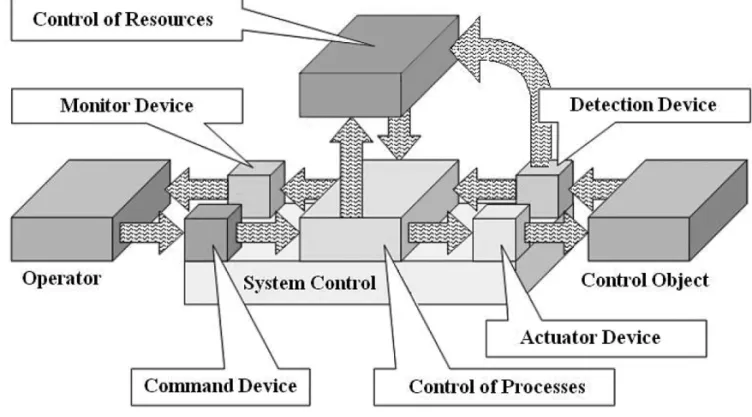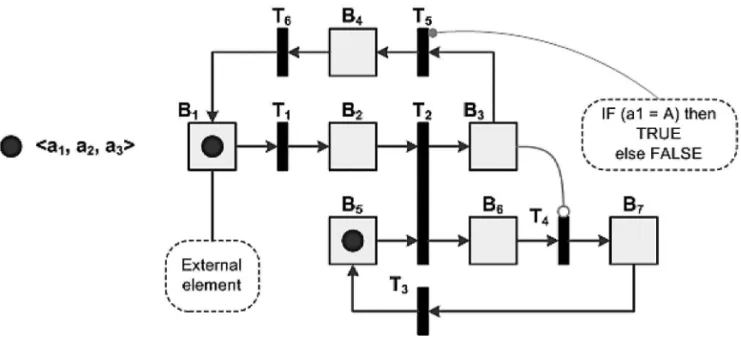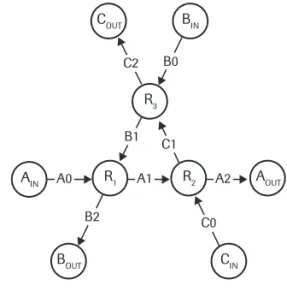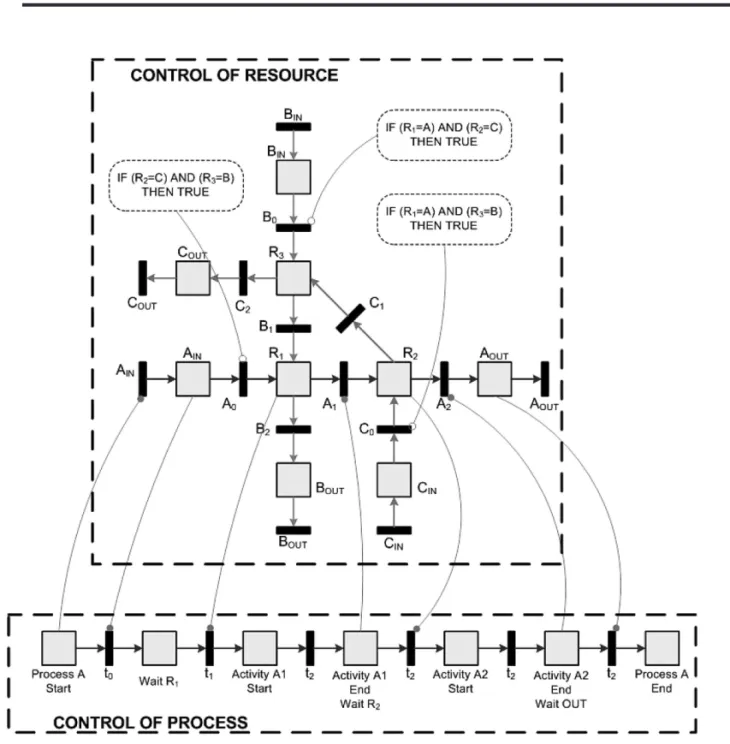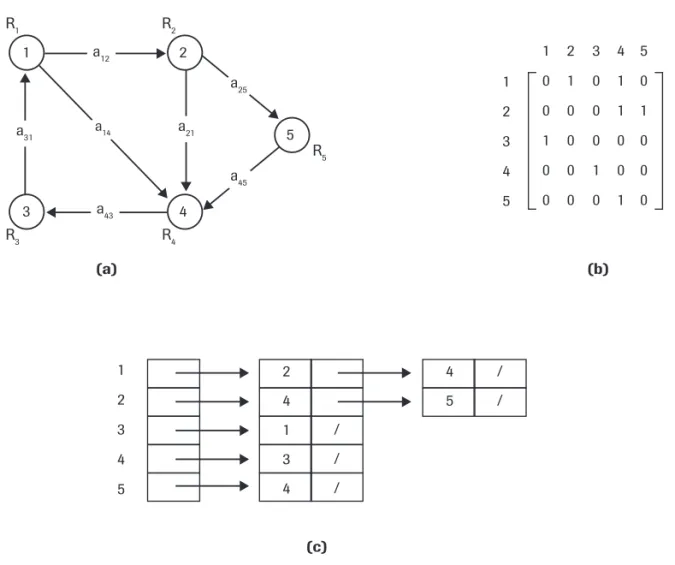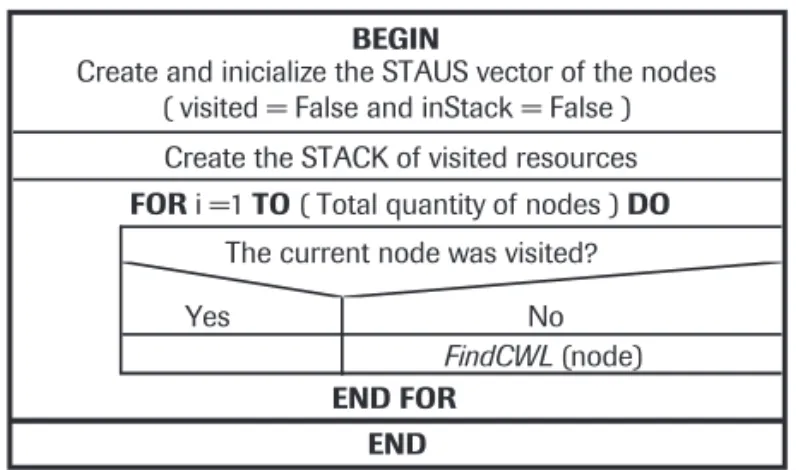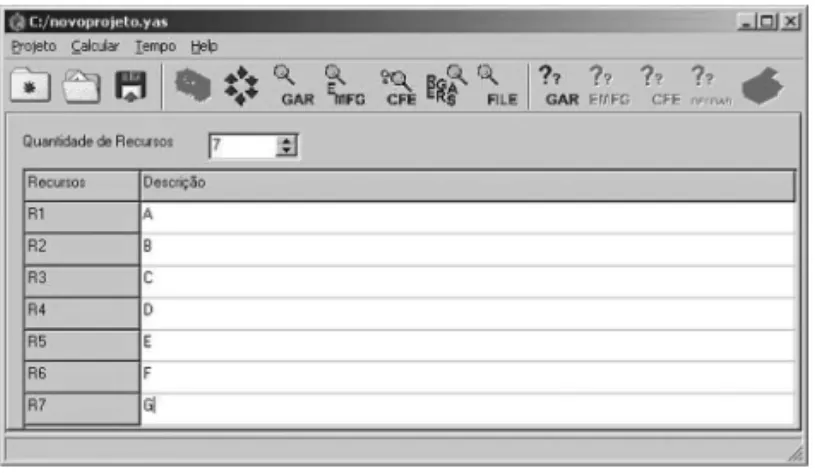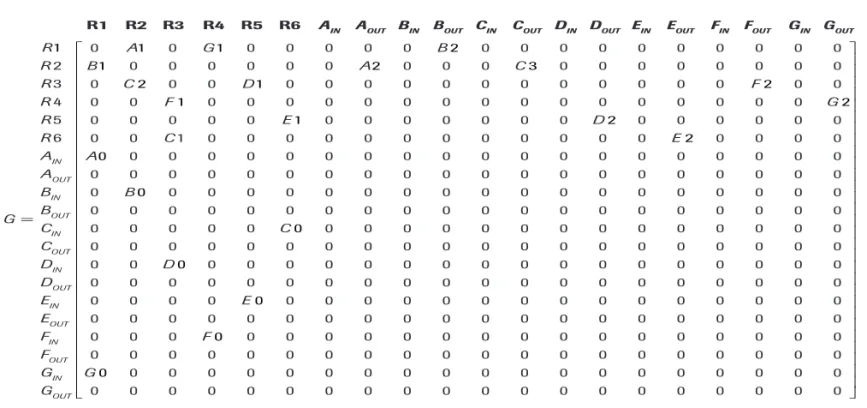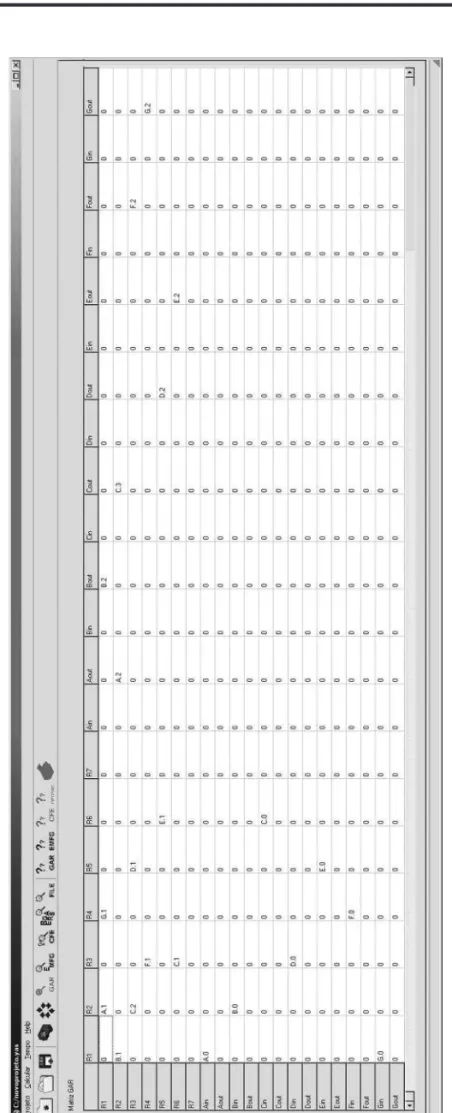Geração automática da solução de controle para
alocação de recursos utilizando redes de Petri
RESUMO
O sistema fl exível de manufatura (FMS fl exible manufacturing system) executa múltiplos processos simultaneamente que utilizam um conjunto li-mitado de recursos. Estes processos podem fi car permanentemente bloqueados em função da seqüência de atividades, isto é, o compartilhamento de um conjunto fi nito de recursos pode levar o sistema a um estado de autotravamento. O FMS pode ser visto como pertencente a uma classe de sistema a eventos discretos, onde não é possível determinar quando um evento ocorre e com isto a seqüência de eventos fi ca indefi nida. Este tipo de sistema pode ser modelado através de rede de Petri e assim explora-se esta técnica para desenvolver uma solução para o problema de auto-travamento considerando o indeterminismo do FMS. O objetivo é introduzir uma abordagem algorítmica para a implementação de uma ferramenta computacional baseada na especifi cação funcional do FMS e que automatize a geração de uma estratégia de controle para a utilização de recursos e de regras para evitar o autotravamento.
PALAVRAS-CHAVE
Sistema fl exível de produção, autotravamento de processos, rede de Petri, controle de sistemas de produção, alocação de recursos.
ABSTRACT
The fl exible manufacturing system (FMS) executes multiple processes simultaneously using a limited set of resources. These processes can be blocked permanently due to the sequence of the activities, i.e., the processes sharing a fi nite set of resources may eventually lead to a deadlock state. The FMS belongs to the class of discrete event systems where it is not possible to determine when an event will occur and the sequence of events becomes unde-fi ned. Such systems can be modeled using Petri net, and this work presents a method that solves the deadlock problem considering the indeterminism of FMSs. The goal of this work is to introduce an algorithmic approach, which allows the implementation of a computer program based on FMS functional specifi cation. The proposal is to automate the generation of the control strategy for resource utilization and the rules to avoid the deadlock situation.
KEY WORDS
Flexible manufacturing system, deadlock avoidance, Petri net, production system control, resource allocation.
Automatic generation of control solution for
resource allocation using Petri net model
Francisco Yastami Nakamoto Centro Universitário Fundação Santo André
Paulo Eigi Miyagi EPUSP
1. INTRODUCTION
Product life cycles in the manufacturing systems are changing constantly and the variability of these products has been increasing in order to meet the needs of the market. h erefore, it is necessary to use a system architecture that allows more l exibility. h e l exibility concept should guarantee a level of adequate productivity to meet the needs of the market with a better utilization of resources. Consequently, this situation increases the complexity of the control system.
h e Flexible Manufacturing System (FMS) is characterized by the simultaneous execution of several processes, sharing the same set of resources. h e FMS belongs to the Discrete Events Dynamic Systems (DEDS) class (HO; CAO, 1991; CASSANDRAS, 1993; MIYAGI, 1996). h e main characteristic of the DEDS is the dynamic behavior, which is based on the occurrence of instantaneous events that cause an abrupt transition from one discrete state to another. Moreover, it is possible to verify the occurrence of indeterminism, conl ict and parallelism of the events.
h e control of only one process in FMS is relatively simple since it is just to guarantee the sequencing of activities or stages of the process. However, the simultaneous execution of multiple processes with intense
sharing of the i nite set of resources may eventually result in a permanent blockage of the system. Such situation is called deadlock or deadlock state (VISWANADHAM et al., 1990; BANASZAK; KROGH, 1991; CHO, 1993; KUMARAN et al., 1994).
h is phenomenon occurs when the l ow of processes is permanently interrupted and/or when the operations of the processes can no longer be executed. h ere are three basic approaches to deal with the deadlock problems (FANTI et al., 2000; SANTOS FILHO, 2000): (i) deadlock detection and recovery, (ii) deadlock avoidance and (iii) deadlock prevention.
A brief analysis the approaches developed in the last ten years concerning the deadlock problems in FMS context basically introduces two research lines:
h e identii cation of a global process and development of •
the respective control system (deadlock prevention); h e identii cation of undesirable states and development •
of the respective control system based on restrictions (deadlock avoidance and deadlock detection and reco-very), i.e., the system does not allow an evolution to the undesirable states.
In a FMS, each process executes a pre-dei ned sequence of activities and executes each activity using a specii c
resource. When two or more processes compete for a limited number of resources, the system can evolve into a deadlock situation.
The occurrence of deadlock in FMS is due to the presence of the following conditions (COFFMAN et al., 1971; BANASZAK; KROGH, 1990; CHO, 1993; FANTI et al., 1997; SANTOS FILHO, 2000): (i) Mutual exclusion, (ii) Await (hold and wait), (iii) No preemption and (iv) Circular wait condition.
h e deadlock will occur if all the previous conditions are true at same time. h us, the system will not evolve for the deadlock situation if at least one of the conditions above is never satisi ed. In a FMS, the i rst three conditions can always occur, that is, two or more processes cannot use the same resource simultaneously and only the process that allocates a resource can release it. Consequently, at er the conclusion of the activity of the process, the retention of resource occurs while the process awaits the release of resources held by another process in the same set. h e occurrence of a cyclic chain of processes in this term constitutes the circular wait condition. h erefore, the circular wait condition remains as the condition that can be controlled.
h is work aims to present an algorithmic approach based on the deadlock avoidance method for FMS proposed by Santos Filho (SANTOS FILHO, 2000) that allows the computational implementation to generate the resource control algorithm for FMS automatically. h e resource control algorithm supervises the processes regarding the resources allocation and it accomplishes decisions in real time to avoid the deadlock situation.
2. RELATED WORK
Viswanadham (VISWANADHAM et al., 1990) proposed the implementation of deadlock prevention by using the reachability graph on Petri net models. However, due to the impossibility of identii cation of all reachable states, the author proposed the algorithm for a real-time controller using the deadlock avoidance method in Petri net-based model.
Interestingly, the approach adopted by Ezpeleta (EZPELETA et al., 1995) consists of the application of the
T
he Flexible Manufacturing System (FMS) is
Basically, the control policy verii es the relation between initial state and the total capacity of the buf er and establishes the restriction of the entrance of the process in a buf er according to this verii cation.
h e applications of the deadlock prevent method are interesting from the point of view of small size FMS. However, they are not feasible for real systems due to the quantity of variables, which can result in an explosion of reachable state of the system.
On the other hand, the deadlock avoidance method is characterized by an approach to the deadlock problems based on restriction policy. Banaszak (BANASZAK; KROGH, 1990) proposed a modeling of FMS using the Petri net model and the application of an algorithm to avoid the deadlock problems called deadlock avoidance algorithm (DAA). h e DAA allows the evolution of the marks in the net according to the control policy.
Fanti (FANTI et al., 1997) proposed a control strategy to be applied to the resources control using the graph-theoretical framework. h e authors introduce two types of digraphs, named working procedure digraph and transition digraph. Moreover, Fanti (FANTI et al., 2000) presented the connections between the graph-theoretical approach and
Petri net models to deal with the deadlock problems in FMS with deadlock avoidance method. Hsieh (HSIEH, 2000) proposed a framework for generating a deadlock avoidance control synthesis algorithm by using the controlled Petri net model, called controlled assembly Petri net (CAPN) model. h e algorithm analyzes the liveness conditions, vulnerability and reconi gurability of CAPN for dealing with the addition and removal of processes, as well as the identii cation of the possible fragile part in the manufacturing systems to provide robustness.
Santos Filho (SANTOS FILHO, 2000) proposed the deadlock avoidance method for FMS based on the restriction model by division of the control system into two levels of control: (i) control of processes, and (ii) control of resources. Both levels are complementary and have distinct semantics. Basically, the algorithm monitors the system regarding the occurrence of the previous deadlock situation. Once the previous state is identii ed, the algorithm accomplishes actions to avoid the evolution of the system for this undesirable state.
More recently, Fanti (FANTI, 2004) proposed the application of the deadlock avoidance method using a hierarchical structure of control system of FMS with two levels using the colored timed Petri net model. h e i rst level determines the restriction policies based on graph-deadlock prevent method with an ordinary and conservative
Petri net model called Systems of Simple Sequential Processes with Resources (S3PR). h e authors analyze the structural element in the net called siphon (PETERSON, 1981; REISIG, 1985; MURATA, 1989). Basically, an algorithm identii es the siphons on the Petri net model and inserts a place to restrict and control the evolution of the marks in the siphon. Moreover, Ezpeleta (EZPELETA et al., 2002) proposed an extension of Banker’s algorithm (CORMEN et al., 2003) applied in a S3PR model with l exible routing and multiple instances of dif erent kinds of resource. Here we observe the increasing demand for more and more l exible systems. Accordingly, Ezpeleta (Ezpeleta and Recalde, 2004) presented the approach to the deadlock problem in non-sequential resource allocation systems (NS-RAS). h is approach uses the deadlock prevention and avoidance concept based on partial reachability graph on Petri net models with an adaptation of the Banker’s algorithm in l exible part routing presented in Ezpeleta (EZPELETA et al., 2002). In both of works presented by Ezpeleta (EZPELETA et al., 2002; EZPELETA; RECALDE, 2004) we can verify a high degree of dii culty to determine the siphons in the Petri net model.
Li (LI; ZHOU, 2003; LI; ZHOU, 2004) proposed the concept of elementary siphons in S3PR. h e siphon control is applied adding a control place for each elementary siphon to make sure that it is always marked. h is approach reduces the number of control places because it is not necessary to add control places in the redundant siphons.
Using another approach based on deadlock prevent method, Banaszak (BANASZAK, 1997) investigated the deadlock problem in a class of FMS called sequential repetitive production systems. The author proposed a distributed buf er control policy that restricts the process entrance in a buf er of a local machine in a specii c sequence. Basically, the rules identify the critical situation of resource allocation and restrict the process entrance according to the capacity of resources, transport timing and resource utilization. Moreover, Banaszak (BANASZAK; POLAK, 2002) presented a study of relationship between system resource capacities and an initial state with priority rules allocation in sequential repetitive production systems.
W
hen two or more processes compete for a
theoretical framework (FANTI et al., 1997; 2000) and the second level is responsible for the management of the l ows of the processes. h e division approach has been adopted by Wu e Zhou (WU; ZHOU, 2005; 2007). h e authors applied the deadlock avoidance method for the solution of the deadlock problem in automated guided vehicles systems using the colored Petri net model.
The division approach of the control allows an improvement for the treatment of the dif erent semantics involved in the control system of the FMS, that is, the sequence control of activities of the processes and the resources allocation control. Consequently, this approach facilitates the development of the control system.
As presented previously, the control system of FMS must adapt to the changes in the production environment quickly, according to market demand. We can note that the complexity is inherent to the FMS. h us, for the systems addressed in this work, the deadlock avoidance method is the most indicated.
3. CONTROL OF FLEXIBLE MANUFACTURING SYSTEMS
h e control system accomplishes previously established functions to reach a pre-dei ned objective (MIYAGI, 1996). In FMS context, such functions involve the execution of activities of the processes.
Some important aspects must be considered for the modeling of the control system: (i) the complexity of FMS, (ii) the architecture of the control system, and (iii) the modeling and analysis tools. h e concept of complexity can be dei ned in many ways and in dif erent
contexts, i.e., there is no general dei nition for every situation. h e term “complexity” comes from the Latin ‘complexus’, which means interlaced or twisted together. According to Edmonds (EDMONDS, 1995), the complexity is the property of representation in which the global behavior is hard to be formulated even when all information about the components
and their interrelations are provided. In the FMS context, the complexity is a property that the global model of the system may have (SANTOS FILHO, 2000). In other words, complexity can arise when a certain behavior is imposed on FMS.
The imposition of a behavior for a single process is relatively simple, it is enough to guarantee the predetermined sequence of activities of the processes. However, in the global context, it is not possible to
determine the behavior of the system based on purely sequential manner of activities.
h e complexity of the global process in FMS is due to the occurrence of two levels of indeterminism (SANTOS FILHO, 2000):
Indeterminism regarding time: It is not possible to deter-•
mine when a certain event is going to occur;
Indeterminism regarding the sequence of events: It is not •
possible to determine which event precedes another. h at situation is due to the execution of simultaneous processes sharing the same set of resources. Consequently, it is not possible to prescribe the system behavior as a whole in this context.
Both levels of indeterminism are increased according to the number of processes, number of resources and other variables of the manufacturing systems. h e solution adopted in this work encompasses four fundamental aspects.
h e i rst one is based on restriction model (SANTOS FILHO, 2000). Restriction model is considered because it is impossible to determine all reachable states of the system for the development of a global control.
h e second aspect is related to the human element, i.e., the approach adopted in this work is the anthropocentric control systems (ITO, 1991); in other words, the human element is considered a fundamental component of the system. h e anthropocentric systems incorporate new technologies in which the human element retains the knowledge and participates in requisite specification, development, implementation and monitoring. Whenever necessary, the human element executes actions that interfere in the dynamics of the system.
h e third aspect refers to the division of the control system in two levels of control (SANTOS FILHO, 2000):
Control of Processes (CP): responsible for sequencing the •
activities of the processes, allocating available resources; Control of Resources (CR): responsible for managing the •
utilization of resources by processes.
Figure 1 presents the architecture of system control proposed by Santos Filho (SANTOS FILHO, 2000). h e
T
he resource control algorithm supervises the
operator monitors the CP through the monitor device and the operator will be able to interfere in the CP through the command device.
h e CP must execute the sequence of activities of the process. h e execution of the activities requires the allocation of the resources, thus, the CP requests the utilization of the resource for the CR. h e CR can view of the global utilization of resource. Thus, according to the policy allocation
(restriction policies or production rules), the CR will be able to authorize the request or not. h e CP accomplishes the control (control object) through the detection device and actuator devices.
h e fourth aspect is the automatic generation of the CR. As presented previously, the control system of FMS must adapt to the changes in the production environment quickly according to market demand. h us, we observe the
importance of generating the control algorithm quickly form.
4. MODELING TOOLS
Considering the four aspects introduced previously, the adequate choice of the modeling tools can considerably inl uence the modeling process of the control systems of FMS. In this work, the modeling tools adopted for generation of the control policy rules and the control algorithm of CR are the Resource Allocation Graph (RAG) and Enhanced Mark Flow Graph (E-MFG).
4.1 Resource allocation graph
h e RAG model is used to determine the circular wait condition (CWL). Basically, the RAG is an unmarked graph (CORMEN et al., 2003) which represents the resource allocation during the production processes. h e graph consists of:
Nodes, that represent resources used in the process; •
Arcs that represents the stages of the processes. •
Figure 1: The architecture of system control with two levels of control
Fonte: Santos Filho, 2000.
T
he division approach of the control allows an
h e RAG is a set G = (R, A), where R is a set of nodes (resources) R = (R1, R2, R3, ..., Rn) and A is a set of arcs
(process stages) A = (a11, a12, ..., aij) where aij = (Ri, Rj).
h e RAG dei nes an adjacency matrix G[n x n], where n represents the nodes.
For example, consider a process A that uses sequentially the resources R1 and R2. h e AIN represents the entrance
station (loading station) and the AOUT represents the exit
station (unloading station). Figure 2 illustrates the RAG model and the matrix representation form (Figure 3) of process A.
Figure 2: Example of RAG of process A.
Figure 3: Adjacency matrix of process A.
4.2 Enhanced mark fl ow graph
The Enhanced Mark Flow Graph (E-MFG) was proposed by Santos Filho (SANTOS FILHO, 2000). The E-MFG is an extension of Mark Flow Graph (MFG) deduced from the Petri net model proposed by Miyagi (MIYAGI, 1996).
Considering the functional behavior of the system and the accomplishment of control, the MFG allows the structural representation of complex sequential systems. h erefore, the system can easily be interpreted by observing the model. According to the Figure 4, the basic elements of MFG are: box, transition, output signal arc and external element, inhibitor arc, enabling arc and oriented arc.
Figure 4: Basic elements of MFG
Fonte: Miyagi, 1996.
h e modeling of the FMS using MFG model becomes limited due to the complexity of system. Consequently,
the E-MFG was introduced to overcome the limitation of MFG (SANTOS FILHO, 2000). h e marks in the E-MFG have attributes, which allow the model a larger degree of abstraction. For example, in Figure 5 the box B1 has a mark with three attributes <A, 2, 4> and the box B5 has an another mark with three attributes <A, 2, 4>.
h e i re of the transition T1 allows the evolution of the
mark in the box B1 to the box B2, which enables the transition
T2. h e i re of the transition T2 allows the evolution of the
mark in the box B3 and the box B6. h e mark in B3 inhibits
the transition T4 through the inhibitor arc.
The external element is connected to the transition T5
by an enabling arc. In this example, the rule associated to the external element is true. Therefore, the transition T5
allows the evolution of the mark in the box B4. The mark
in B1 allows the signal to the external element through the
output signal arc.
5. SYNTHESIS OF THE METHOD TO DESIGN RESOURCE ALLOCATION CONTROL
h e generation of the CR depends on the information about the set of available resources of the FMS and the sequences of resource allocation by the processes. h e control policy rules are obtained by following the sequence of steps:
Create the individual RAG for each process; I.
Create the global RAG through of the fusion common II.
nodes;
Determine the CWL in the global RAG; III.
Deduce the control policy rules of resources allocation IV.
based on “IF... THEN...” model from the set of CWL. h e determination method of the CWL proposed by Santos Filho (SANTOS FILHO, 2000) was the sequence of adjacency matrix multiplication of RAG model. At er each matrix multiplication, the CWL are presented in the main diagonal of the result matrix.
For example, consider a set of resources R = {R1, R2,
R3} and a set of processes P = {A, B, C} with the following
resources utilization sequence presented in Figure 6.
Figure 6: Adjacency matrix of process A.
h e fusion of the common nodes of the individual RAG from each process generates another RAG model called
Global RAG model. Figure 7 presents the Global RAG model of previous example and the respective CWL is formed by the set of resources R1, R2 and R3.
h e control policy rules must avoid the deadlock situation. The previous deadlock situation is characterized when only one resource is available in the CWL. Under this condition, it is necessary to identify the entrance of the process that causes the deadlock situation.
Figure 7: Example of Global RAG and the CWL.
Considering the example in Figure 7, we identify three previous deadlock situations in CWL:
IF
• (R1 is used by process A) AND (R2 is used by process
C) THEN (avoid the entrance of process B in the CWL);
W
henever necessary, the human element
IF
• (R1 is used by process A) AND (R3 is used by process B) THEN (avoid the entrance of process C in the CWL); IF
• (R2 is used by process C) AND (R3 is used by process B) THEN (avoid the entrance of process A in the CWL).
Therefore, one rule is determined for each resource in the CWL that has an entrance of process. Behind
determine the control polic y rules; the control algorithm of CR is obtained by following the sequence of steps:
I. Create the individual E-MFG from individual RAG of the processes (Figure 8). h is formalism was introduced by Santos Filho (SANTOS FILHO, 2000). Once that RAG is a transition graph that represents a i nite
auto-Figure 8: Individual E-MFG models from the RAG models.
The CP realizes the control of sequence of the activities of the process. Figure 10 presents the communication of CR and the control of process A in CP.
The validation of the models CR and CP were accomplished by Santos Filho (SANTOS FILHO, 2000) based on mapping of signal communication between models.
5.1 Algorithmic Approach
h e computational resources are fundamental tools in several systems for accomplishing the data processing, data storage and the control execution. According to Ziviani mata (REISIG, 1985), It is possible mapping the graph
into a net (CASSANDRAS, 1993);
II. Map the global E-MFG from the individual E-MFG through of the fusion common boxes (SANTOS FILHO, 2000) (Figure 8);
III. Associate the control policy rules to the transitions in global E-MFG (Figure 9). h e E-MFG is represented by incidence matrix (DROZDEK, 2002; CORMEN et al., 2003; ZIVIANI, 2004).
The communication of the CP and CR is accomplished with the enabling arcs in the transitions of E-MFG Models.
(ZIVIANI, 2004), the development of the computers program is basically built with the data structure and the algorithms. h e form in which the data will be processed depends on the representation of these data. h e computational evolution allows the access for faster processors and a larger storage of data with reduced costs. h ese facts allow the complex data structure implementation and algorithms, which were unfeasible before. In this section the data structures adopted to determine the CWL and of the additional rules of control will be introduced.
Considering the synthesis of the method presented previously, an algorithmic approach is applied for:
h e four steps to generate the CWL and the set of control •
policy rules to avoid deadlock situation, and;
h e three steps to generate the algorithm control of the •
CR.
The RAG is used to determine the condition of CWL. For example, Figure 11a presents an example of RAG
with three CWLs: {R1, R2, R4 and R3}, {R1, R4 and R3} and
{R1, R2, R5, R4 and R3}. The representation of a RAG G =
(R, A) is based on the adjacency list (NAKAMOTO et al., 2007) instead of the adjacency matrix proposed in Nakamoto (NAKAMOTO et al., 2003). The adjacency list consists of an array Adj of |R| lists, one for each resource in R. For each Ri∈ R, the adjacency list Adj[R] contains
all the resource adjacent to R in G. Figure 11b and 11c presents an example of adjacency matrix representation and adjacency list representation.
The tabular form representation of the adjacency list is denominated the Star (DROZDEK, 2002), which can be direct (ForwardStar) or inverse (ReverseStar). The algorithm uses these formats to determine the previous and the posterior node in the RAG model. The great advantage of the adjacency list representation is the complexity of the algorithm to determine the CWL in RAG model, in comparison to the adjacency matrix adopted in Nakamoto (NAKAMOTO, 2002; NAKAMOTO et al., 2003).
h e adjacency matrix multiplication algorithm proposed by Santos Filho (SANTOS FILHO, 2000) has the complexity
Θ(R3). Nakamoto (NAKAMOTO, 2002; NAKAMOTO et
al., 2003) proposed the algorithm to determine the CWL based on depth-i rst search algorithm (CORMEN et al., 2003) applied in adjacency matrix, in which the complexity of this algorithm is Θ(R2). In comparison, the same
depth-i rst search algordepth-ithm appldepth-ied depth-in the adjacency ldepth-ist has the complexity Θ(R+A) (DROZDEK, 2002; CORMEN et al.,
2003; ZIVIANI, 2004). Consequently, the adjacency list representation allows a better performance of computational processing time to determine the CWLs in RAG.
Once the data structure is dei ned, the algorithm executes a depth-i rst search in an adjacency list of RAG (searching CWLs). Basically, the strategy is to search the most depth possible in the RAG. h e algorithm verii es to each node discovered if there are unexplored adjacent arcs. When all the adjacent arcs are explored, the algorithm returns to the
predecessor node and explores the rest of adjacent resource not yet explored. A CWL is found if the resource discovered was visited previously. Figure 12 illustrates the example of the sequence execution to determine the CWL formed by the resources {R1, R2, R4 and R3}. The research sequence is initiated in the node 1. Node 1 owns two adjacent arcs a12 and a14. From the arc a12, the algorithm discovers node 2 that is inserted in the stack. From node 2, the algorithm discovers node 4 by the adjacent arc a24. When the algorithm finds a node visited previously then it has discovered a CWL.
Figures 13 and 14 present the proposed algorithm and the auxiliary functions. The algorithm determines the CWL when a resource visited previously is discovered. Before inserting CWL in the list, the algorithm verifies if the CWL is already in the list. The algorithm uses the auxiliary data structures to find CWL and insert in the list: data structure stack and status vector of resource. The data
structure stack is used to store the discovered nodes in the RAG graph. For each node discovered, the respective attribute in the status vector is changed indicating that it was discovered.
Figure 13: Algorithm to determine the CWL.
h e control policy rules to avoid the deadlock situation are generated from the set of CWLs determined by the detection algorithm previously introduced. For each CWL, it is necessary to identify all entrances of the process into the cycle. h e pre-deadlock condition is characterized when only one resource is available, considering that the others
resources in CWL are allocated by the processes. Under this condition, the control algorithm must avoid the entrance of the process that causes the deadlock. Figure 15 presents the algorithm to deduce the control policy rules to avoid the deadlock situation.
Figure 15: Algorithm to deduce the control policy rules.
h e algorithmic approach allowed the development of computer program that generates automatically the control algorithm using the information of the resources, the information of the processes and the sequence of the activities. h e sot ware was developed in the IBM-PC Windows XP platform using Borland Delphi 6.
6. CASE STUDY
Consider the following system: processes (A, B, C, D, E, F and G) and resources (R1, R2, R3, R4, R5 and R6). h e
resources utilization sequence by the processes is presented in Table 1.
Table 1: Resource utilization sequence by the processes.
Process Resource Utilizacion Sequence
A R1, R2
B R2, R1
C R6, R3, R2
D R3, R5
E R5, R6
F R4, R3
G R1, R4
The following sequence is introduced using the computer program:
a) The insertion of data about the resources (Figure 16);
Figure 16: Interface to insert data on the resources.
b) h e insertion of data about the processes (Figure 17);
Figure 17: Interface to insert the sequence of activities of the processes.
c) Determination of global RAG. Figure 18 presents the global RAG, Figure 19 presents the adjacency matrix and Figure 20 the interface of the program with the adjacency matrix of global RAG;
d) h e determination of the CWL. h e algorithm is applied to adjacency matrix of global RAG that determines all CWL. Figure 18 presents the three CWLs in global RAG; e) h e determination of global E-MFG. h e global E-MFG
is generated from the global RAG, according to the Figure 22. Figure 23 presents the incidence matrix of global E-MFG determined by the program;
f) h e determination of the control policy rules to avoid the deadlock in FMS. Figure 23 presents the CWL with the control rules and Figure 24 presents the rules determined by the program.
7. CONCLUSION
Figur
e 20: Adjacency matrix of global R
AG determined by the pr
ogr
Figure 21: Determination of CWL.
Figure 23: Incidence matrix of global E-MFG.
CWL Rules to avoid deadlock state E1/C1/D1
IF (R3=D) AND (R5=E) THEN C0=FALSE IF (R5=E) AND (R6=C) THEN D0=FALSE IF (R3=D) AND (R6=C) THEN E0=FALSE
F1/C2/B1/G1
IF (R1=G) AND (R2=B) AND (R3=C) THEN F0=FALSE IF (R1=G) AND (R2=B) AND (R4=F) THEN C1=FALSE IF (R1=G) AND (R3=C) AND (R4=F) THEN B0=FALSE IF (R2=B) AND (R3=C) AND (R4=F) THEN G0=FALSE B1/A1 IF (R1=A) THEN B0=FALSE
IF (R2=B) THEN A0=FALSE
Artigo recebido em 08/04/2008
Aprovado para publicação em 10/10/2008
REFERENCES
BANASZAK, Z. A.; KROGH, B. H. Deadlock Avoidance In Flexible Manufacturing Systems with Concurrently Competing Process Flows. In: IEEE Transactions on Robotics and Automation, v. 6, p. 724-734, 1990.
BANASZAK, Z. A.; POLAK, M. Deadlock-free Distributed Control for Repetitive Flows. Proceedings of the Sixth International Workshop on Discrete Event Systems, p. 273-278, 2002. CALINESCU, A.; EFSATHIOU, J.; SIVADAN, S., SCH I R N, J.; H UACCHO H UATUCI, L. Complexity in Manufacturing: An Information Theoretic Approach. In:Proceedings of the International Conference on Complex Systems and Complexity in Manufacturing, Warwick University, Warwick, 2000.
CASSANDRAS, C. G. Discrete Event Systems – Modeling and Performance Analysis, Richard D. Irvin, Inc. and Aksen Associates, Incorporated Publishers, p. 1-139, 1993.
CHO, H. An Intelligent Workstation Controller for Computer Integrated Manufacturing, Doctor dissertation, Texas A&M University, p. 83-88, 1993.
C O F F M A N, E. G. J R.; E LP H I C K, M. J.; SHOSHANI, A. System Deadlocks. In: Computing Surveys, v. 3, n. 2, p. 67-78, June 1971.
CORMEN, T. H., LEISERSON, C. E., RIVEST, E. L.; STEIN, C. Introduction to Algorithms, 2nd
Edition, McGraw-Hill, 2003.
DROZDEK, A. Estrutura de Dados e Algoritmos em C++”, Editora Pioneira Thomson Learning, 2002.
EDMONDS, B. What is Complexity? – The Philosophy of Complexity per se with Application to some Examples. In: Evolution, Symposium: The Evolution of Complexity, University of Brussels, Brussels, Belgium, 1995.
EZPELETA, J.; TRINCAS, F.; GARCIA VALLES, F.; COLOM, J. M. A Banker’s Solution for Deadlock Avoidance in FMS with Flexible Routing and Multiresource States. In: IEEE Transactions on Robotics and Automation, v. 18, p. 621-625, 2002.
EZPE LETA, J.; R ECALDE, L. A Deadlock Avoidance Approach for Nonsequential Re source Alloc ation Systems. In: I E E E Transactions on Systems, Man and Cybernetics, Part A, v. 34, p. 93-101, 2004.
FANTI, M. P.; MAIONE, B.; MASCOLO, S.; TURCHIANO, B. Event-Based Feedback Control for Deadlock Avoidance in Flexible Production Systems. In: IEEE Transaction on Robotics and Automation, v. 13, n. 3, p. 347-363, 1997.
FANTI, M.P.; MAIONE, B.; MASCOLO, S.; TURCHIANO, B. Comparing Digraph and Petri Net Approaches to Deadlock Avoidance in FMS. In: IEEE Transaction on Systems, Man, and Cybernetics, v. 30, n. 5, p. 783-798, 2000.
HSIEH, F. S. Reconfigurable Fault Tolerant Deadlock Avoidance Controller Synthesis for Assembly Production Processes. In: Proceedings of IEEE International Conference on Systems, Man, and Cybernetics, v. 4, p. 3045-3050, 2000.
HSIEH, F. S. Modeling and Control of Holonic Manufacturing Systems Based on Extended
Contract Net Protocol. In: Proceeding of the American Control Conference, v. 6, p. 5037-5042, 2002.
HO, Y. C.; CAO, X. R. Perturbation Analysis of Discrete Event Dynamic Systems, Kluwer Academics Publishers, 1991.
ITO, Y. A Diserable Production Structure Lookin Toward the 21th Century – Anthropocentric I n t e l l i g e n c e - B a s e s M a n u f a c t u r i n g . X I Congresso Brasileiro de Engenharia Mecânica, São Paulo, Brazil, p. 23-32, 1991.
KUMARAN, T. K.; CHANG, W.; CHO, H.; WYSK, R. A. A Structured Approach to Deadlock Detection, Avoidance and Resolution in Flexible Manufacturing Systems. In: International journal of production research, v. 32, n. 10, p. 2361-2379, 1994.
LAWLEY, M.; REVELIOTIS, S.; FERREIRA, P. Design Guidelines for Deadlock Handling Strategies in Flexible Manufacturing Systems. In: The International Journal of Flexible Manufacturing Systems, v. 9, p. 5-30, 1997.
M I YA G I , P. E . P r o g r a m m a b l e C o n t r o l : Fundaments of Discrete Event System Control. Sao Paulo: Ed. Edgard Blucher, 1996, (In Portuguese).
MURATA, T. Petri Nets: Properties, Analysis and Applications. In: Proceedings of the IEEE, v. 77, n. 4, p. 541-580, 1998.
NAKAMOTO, F. Y. Sistematização do Projeto do Controle de Sistemas Produtivos, Dissertação de
ACKNOWLEDGEMENTS
ABOUT THE AUTHORS
Francisco Yastami Nakamoto
Centro Universitário Fundação Santo André Tel.: (11) 4979-3300
E-mail: yastami@fsa.br; francisco.nakamoto@poli.usp.br
Paulo Eigi Miyagi
Escola Politécnica da Universidade de São Paulo Tel.: (11) 3091-5580 Fax.: (11) 3091-5461 E-mail: pemiyagi@usp.br
Diolino José dos Santos Filho
Escola Politécnica da Universidade de São Paulo Tel.: (11) 3091-6025 Fax.: (11) 3091-5461 E-mail: diolino.santos@poli.usp.br
Mestrado. Escola Politécnica da Universidade de São Paulo, São Paulo, Brazil, 2002. (In Portuguese.)
NAKAMOTO, F. Y.; MIYAGI, P. E.; SANTOS FILHO, D. J. Systematization of the Project of the Production System Control. IEEE International Symposium on Industrial Electronics, v. 2, p. 868-873, 2003.
NAKAMOTO, F. Y.; MIYAGI, P. E.; SANTOS FILHO, D. J. Resource Allocation Control in Flexible Manufacturing Systems Using the Deadlock Avoidance Method. In: Proceedings of COBEM 2007 – 19th International Congress
of Mechanical Engineering, November 5-9, 2007, Brasília-DF.
PALAZZO, L. A. M.; CASTILHO, J. M. V. Complex Systems and Self-Organization. VI Regional School of Informatics, Curitiba, PR, Brazil, 1998. (In Portuguese.)
PETERSON, J. L. Petri Net Theory and the Modeling of Systems, Prentice-Hall, 1981.
REISIG, W. (1985) Petri Nets, an Introduction. Springer-Verlag, 1985. Berlin Heidelberg.
SANTOS FILHO, D. J. Aspectos do Projeto de Sistemas Produtivos. Tese de Livre Docência, Escola Politécnica da Universidade de São Paulo, São Paulo, Brazil, 2000. (In Portuguese).
V I S WA N A D H A M , N . ; N A R A H A R I , Y. ; JOHNSON, T. L. Deadlock Prevention and Deadlock Avoidance in Flexible Manufacturing Systems Using Petri Net Models. In: IEEE Transactions on Robotics and Automation, v. 6, n. 6, p. 713-723, 1990.
